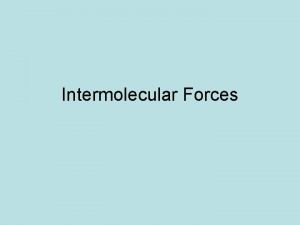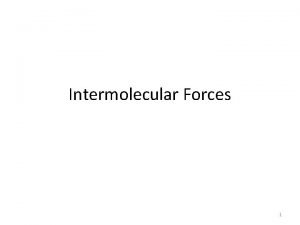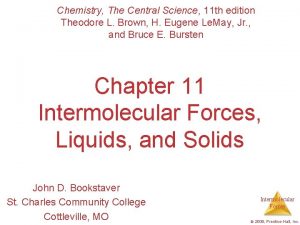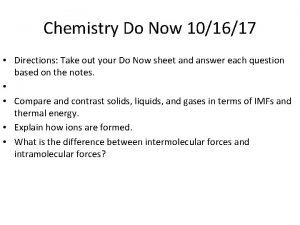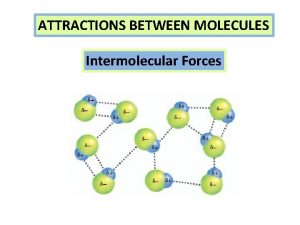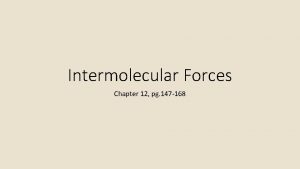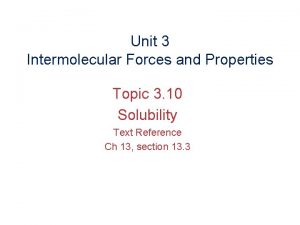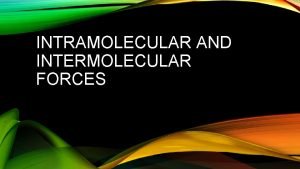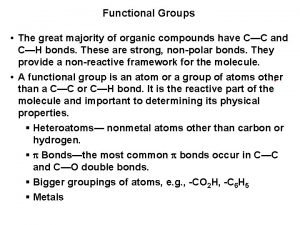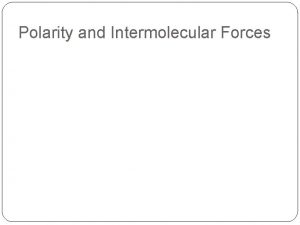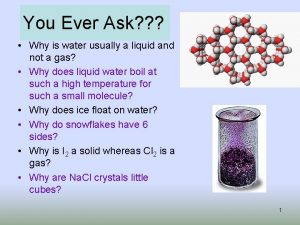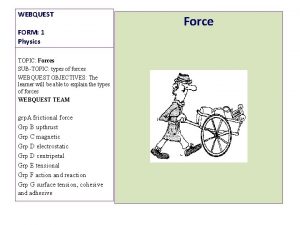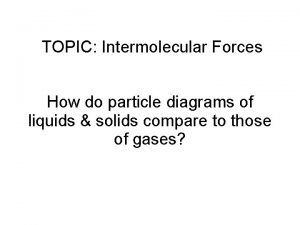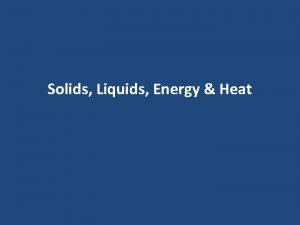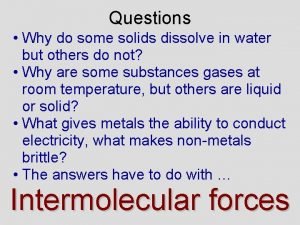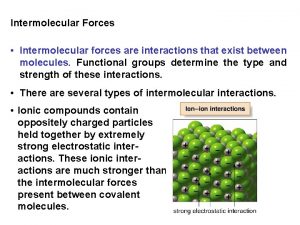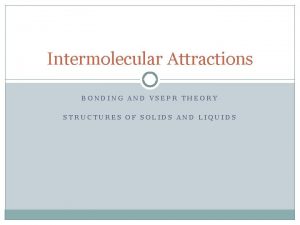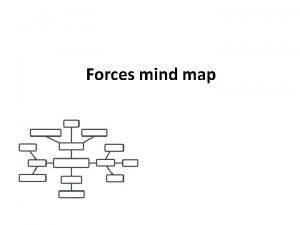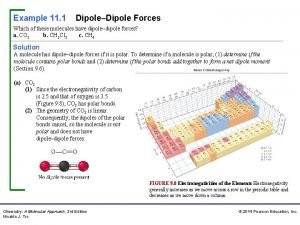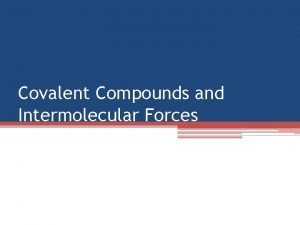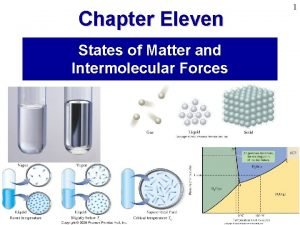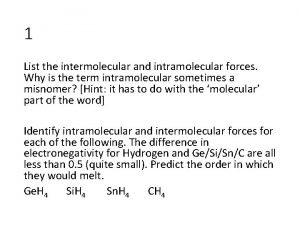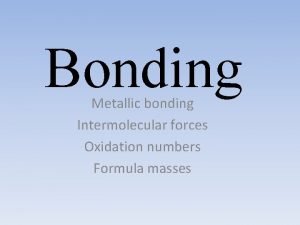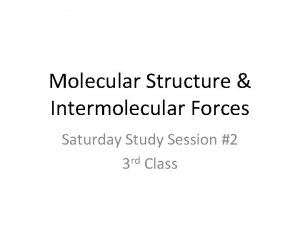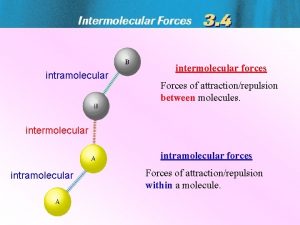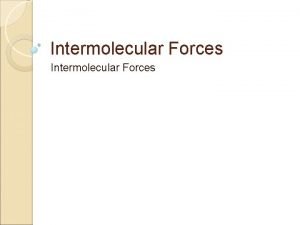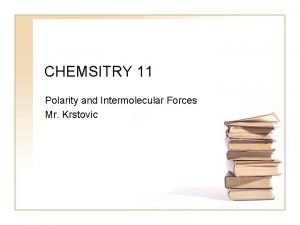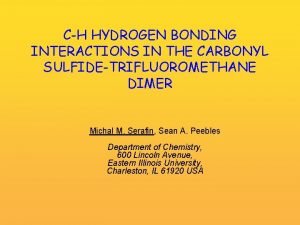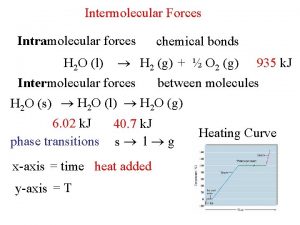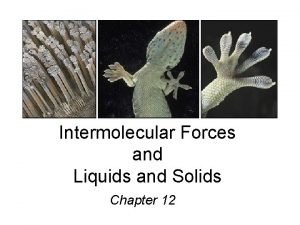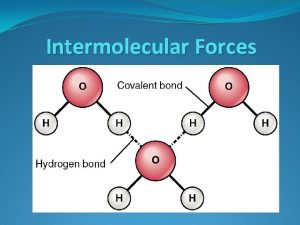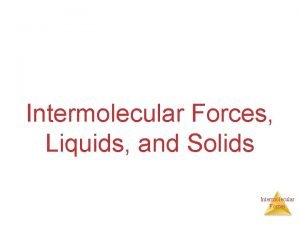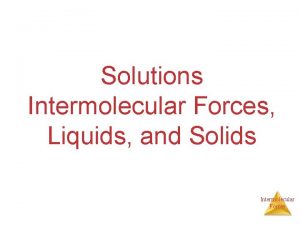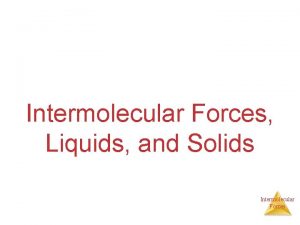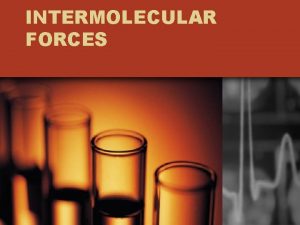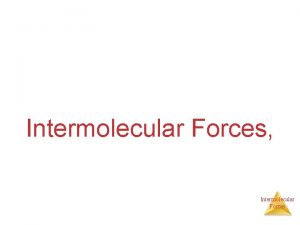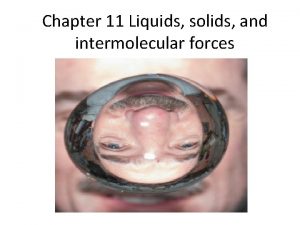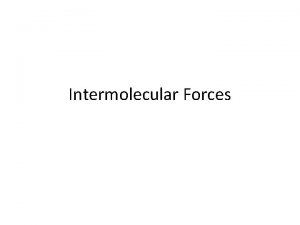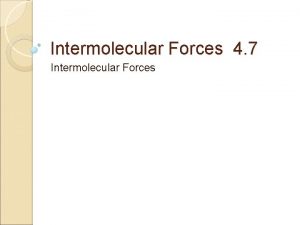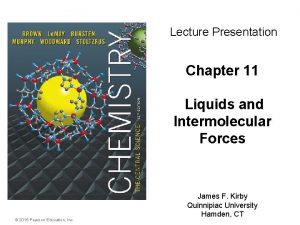Lecture Presentation Chapter 11 Liquids and Intermolecular Forces

















































- Slides: 49

Lecture Presentation Chapter 11 Liquids and Intermolecular Forces James F. Kirby Quinnipiac University Hamden, CT Edited By Brian Fain © 2015 Pearson Education, Inc.

Why does density and state of matter change going down the group of the halogens? © 2015 Pearson Education, Inc.

Plan for Today § Hand back tests § Retakes? Need to schedule a time with Mr. Fain BEFORE BREAK © 2015 Pearson Education, Inc.

Look at the graph below of temperature change vs. time for n-pentane (green) and n-hexane (red). What does it show? Be ready to share. © 2015 Pearson Education, Inc.

Plan for Today § Phase Diagrams § Study Guide Questions © 2015 Pearson Education, Inc.

States of Matter § The fundamental difference between states of matter is the strength of the intermolecular forces of attraction. § Stronger forces bring molecules closer together. § Solids and liquids are referred to as the condensed phases. Intermolecular Forces © 2015 Pearson Education, Inc.

Differences in the States of Matter Intermolecular Forces © 2015 Pearson Education, Inc.

Which State of Matter? • The answer to this question largely relies on the Ø balance between the kinetic energies of the particles. Ø interparticle energies of attraction. Intermolecular Forces © 2015 Pearson Education, Inc.

Intermolecular Forces • The attractions between molecules are not nearly as strong as the intramolecular attractions (bonds) that hold compounds together. • Many physical properties reflect intermolecular forces, like boiling points, melting points, viscosity, Intermolecular surface tension, and capillary action. Forces © 2015 Pearson Education, Inc.

Types of Intermolecular Force • Weakest to strongest forces: Ø dispersion forces (or London dispersion forces) Ø dipole–dipole forces Ø hydrogen bonding (a special dipole–dipole force) Ø ion–dipole forces o Note: The first two types are also referred to collectively as van der Waals forces. Intermolecular Forces © 2015 Pearson Education, Inc.

Dispersion Forces • The figure below shows how a nonpolar particle (in this case a helium atom) can be temporarily polarized to allow dispersion force to form. • The tendency of an electron cloud to distort is called its polarizability. Intermolecular Forces © 2015 Pearson Education, Inc.

Polarizability & Boiling Point • Polarizability increases with atomic size. • Trend in boiling points I 2 > Br 2 > Cl 2 > F 2 • Opposite is also true: less intermolecular force (smaller molecule: lower molecular weight, fewer electrons). Intermolecular Forces © 2015 Pearson Education, Inc.

Polarizability & Boiling Point • Smaller the atom/molecule – Less electrons to move – Less polarizable – Less “sticky” – Lower boiling points • Larger the atom/molecule – More electrons to move – More polarizable – More “sticky” – Higher boiling points © 2015 Pearson Education, Inc. Intermolecular Forces

Polarizability & Boiling Point Intermolecular Forces © 2015 Pearson Education, Inc.

Amount of Dispersion Force in Molecules • number of electrons in an atom (more electrons, more dispersion force) • size of atom or molecule/molecular weight • shape of molecules with similar masses (more compact, less dispersion force) Intermolecular Forces © 2015 Pearson Education, Inc.

Amount of Dispersion Force in Molecules • For hydrocarbons and other non-polar molecules which lack strong dipoles, what holds them together? • Since the dipoles are weak and transient, they depend on contact between molecules – which means that the forces increase with surface area. • A small molecule like methane has very weak intermolecular forces, and has a low boiling point. However, as molecular weight increases, boiling point also goes up. • That’s because the surface over which these forces can operate has increased. • Therefore, dispersion forces increase with increasing molecular weight. © 2015 Pearson Education, Inc. Intermolecular Forces

Dipole–Dipole Interactions • Polar molecules have a more positive and a more negative end–a dipole (two poles, δ+ and δ−). • The oppositely charged ends attract each other. Intermolecular Forces © 2015 Pearson Education, Inc.

Dipole–Dipole Interactions For molecules of approximately equal mass and size, the more polar the molecule, the Intermolecular higher its boiling point. Forces © 2015 Pearson Education, Inc.

Which Have a Greater Effect: Dipole–Dipole Interactions or Dispersion Forces? • If two molecules are of comparable size and shape, dipole–dipole interactions will likely be the dominating force. • If one molecule is much larger than another, dispersion forces will likely determine its physical properties. Intermolecular Forces © 2015 Pearson Education, Inc.

What Does This Graph Show Us? • In a group, the period 3/4/5 elements have higher boiling points as the group member gets larger. • What happens with the period 2 elements? For group 4 A, the trend is continued. What about for the other groups? © 2015 Pearson Education, Inc. Intermolecular Forces

What Does This Graph Show Us? Intermolecular Forces © 2015 Pearson Education, Inc.

Hydrogen Bonding • The dipole–dipole interactions experienced when H is bonded to N, O, or F are unusually strong. • We call these interactions hydrogen bonds. • A hydrogen bond is an attraction between a hydrogen atom attached to a highly electronegative atom and a nearby small electronegative atom in another molecule or chemical group. © 2015 Pearson Education, Inc. Intermolecular Forces

What Forms Hydrogen Bonds? • Hydrogen bonding arises in part from the high electronegativity of nitrogen, oxygen, and fluorine. • These atoms interact with a nearly bare nucleus (which contains one proton). Intermolecular Forces © 2015 Pearson Education, Inc.

Ion–Dipole Interactions • Ion–dipole interactions are found in solutions of ions. • The strength of these forces is what makes it possible for ionic substances to dissolve in polar solvents. Intermolecular Forces © 2015 Pearson Education, Inc.

Intermolecular Forces © 2015 Pearson Education, Inc.

Liquid Properties Affected by Intermolecular Forces • boiling point (previously discussed) and melting point • viscosity • surface tension • capillary action Intermolecular Forces © 2015 Pearson Education, Inc.

Viscosity • Resistance of a liquid to flow is called viscosity. • It is related to the ease with which molecules can move past each other. • Viscosity increases with stronger intermolecular forces and decreases with higher temperature. Intermolecular Forces © 2015 Pearson Education, Inc.

Surface Tension • Water acts as if it has a “skin” on it due to extra inward forces on its surface. Those forces are called the surface tension. Intermolecular Forces © 2015 Pearson Education, Inc.

Surface Tension Intermolecular Forces © 2015 Pearson Education, Inc.

Cohesion and Adhesion • Intermolecular forces that bind similar molecules to one another are called cohesive forces. • Intermolecular forces that bind a substance to a surface are called adhesive forces. • These forces are important in capillary action. Intermolecular Forces © 2015 Pearson Education, Inc.

Capillary Action • The rise of liquids up narrow tubes is called capillary action. • Adhesive forces attract the liquid to the wall of the tube. • Cohesive forces attract the liquid to itself. • Water has stronger adhesive forces with glass; mercury has stronger cohesive forces with itself. © 2015 Pearson Education, Inc. Intermolecular Forces

Capillary Action Intermolecular Forces © 2015 Pearson Education, Inc.

Phase Changes • Conversion from one state of matter to another is called a phase change. • Energy is either added or released in a phase change. • Phase changes: melting/freezing, vaporizing/condensing, subliming/depositing. © 2015 Pearson Education, Inc. Intermolecular Forces

Intermolecular Forces © 2015 Pearson Education, Inc.

Energy Change & Change of State • The heat of fusion is the energy required to change a solid at its melting point to a liquid. • The heat of vaporization is the energy required to change a liquid at its boiling point to a gas. • The heat of sublimation is the energy required to change a solid directly to a gas. Intermolecular Forces © 2015 Pearson Education, Inc.

Heating Curves • A plot of temperature vs. heat added is called a heating curve. • Within a phase, heat is the product of specific heat, sample mass, and temperature change. • The temperature of the substance does not rise during a phase change. • For the phase changes, the product of mass and the heat of fusion of vaporization is heat. © 2015 Pearson Education, Inc. Intermolecular Forces

Heating Curves Intermolecular Forces © 2015 Pearson Education, Inc.

Supercritical Fluids • Gases liquefies when pressure is applied. • The temperature beyond which a gas cannot be compressed is called its critical temperature. • The pressure needed to compress the liquid at critical temperature is called critical pressure. • The state beyond this temperature is called a supercritical fluid – a highly compressed Intermolecular gas at high temperature. Forces © 2015 Pearson Education, Inc.

Supercritical Fluids Intermolecular Forces © 2015 Pearson Education, Inc.

Vapor Pressure • At any temperature, some liquid molecules have enough energy to escape the surface and become a gas. • As the temperature rises, the fraction of molecules that have enough energy to break free increases. Intermolecular Forces © 2015 Pearson Education, Inc.

Vapor Pressure • As more molecules escape the liquid, the pressure they exert increases. • The liquid and vapor reach a state of dynamic equilibrium: liquid molecules evaporate and vapor molecules condense at the same rate. Intermolecular Forces © 2015 Pearson Education, Inc.

Vapor Pressure Intermolecular Forces © 2015 Pearson Education, Inc.

Vapor Pressure • The boiling point of a liquid is the temperature at which its vapor pressure equals atmospheric pressure. • The normal boiling point is the temperature at which its vapor pressure is 760 torr. Intermolecular Forces © 2015 Pearson Education, Inc.

Phase Diagram • A phase diagram is a graph of pressure vs. temperature for a substance. It shows – melting, boiling, and sublimation points at different pressures. – the triple point and critical point. Intermolecular Forces © 2015 Pearson Education, Inc.

Phase Diagram of Water © 2015 Pearson Education, Inc. • Notice that the triple point for water occurs at a very low pressure. • Notice also that the critical temperature is 374°C. It would be impossible to convert water from a gas to a liquid by compressing it above this temperature. • These are due to the strong van der Waals Intermolecular forces between water Forces molecules.

Phase Diagram of Water Intermolecular Forces © 2015 Pearson Education, Inc.

Phase Diagram of Water • Unusual feature for water: Ø The slope of the solid– liquid line is negative. ü This means that as the pressure is increased, the melting point decreases ü WHY? ? ? Intermolecular Forces © 2015 Pearson Education, Inc.

Phase Diagram of Water • Ice is less dense, it takes up more volume • Pressure goes up, it causes the molecules to take up less volume • To make the liquid water freeze again at this higher pressure, you will have to reduce the temperature. Higher pressures mean lower Intermolecular Forces melting (freezing) points. © 2015 Pearson Education, Inc.

Phase Diagram of Carbon Dioxide • Unusual features for carbon dioxide: Ø cannot exist in the liquid state at pressures below 5. 11 atm (triple point) ü CO 2 sublimes at normal pressures. Intermolecular Forces © 2015 Pearson Education, Inc.
 Intramolecular vs intermolecular
Intramolecular vs intermolecular Intermolecular forces ranked
Intermolecular forces ranked Inter vs intramolecular forces
Inter vs intramolecular forces Intermolecular and intramolecular forces
Intermolecular and intramolecular forces Gecko feet facts
Gecko feet facts Similarities of intermolecular and intramolecular forces
Similarities of intermolecular and intramolecular forces Viscosity and intermolecular forces
Viscosity and intermolecular forces Capillary action and intermolecular forces
Capillary action and intermolecular forces Nof intermolecular forces
Nof intermolecular forces Pg 147
Pg 147 Unit 3 intermolecular forces and properties
Unit 3 intermolecular forces and properties How do london dispersion forces work
How do london dispersion forces work Electronegativity and intermolecular forces
Electronegativity and intermolecular forces Nonpolar functional groups
Nonpolar functional groups Intermolecular forces review
Intermolecular forces review London dispersion forces induced dipole
London dispersion forces induced dipole Forces webquest
Forces webquest Imf
Imf 3 types of intermolecular forces
3 types of intermolecular forces Imf chem
Imf chem Factors that affect solvation
Factors that affect solvation Intermolecular forces present in hbr
Intermolecular forces present in hbr Pvc intermolecular forces
Pvc intermolecular forces Intermolecular forces in formaldehyde
Intermolecular forces in formaldehyde Intermolecular forces symbol
Intermolecular forces symbol Dipole-dipole interaction example
Dipole-dipole interaction example Intermolecular forces strength
Intermolecular forces strength Butanal intermolecular forces
Butanal intermolecular forces Strongest to weakest intermolecular forces
Strongest to weakest intermolecular forces Intermolecular forces from strongest to weakest
Intermolecular forces from strongest to weakest Ch2cl intermolecular forces
Ch2cl intermolecular forces Hydrogen bond intermolecular forces
Hydrogen bond intermolecular forces Mind map about intermolecular forces
Mind map about intermolecular forces Ch2cl intermolecular forces
Ch2cl intermolecular forces Coh2 intermolecular forces
Coh2 intermolecular forces Is matter
Is matter Hybrid bonding
Hybrid bonding Idf
Idf List of intermolecular forces
List of intermolecular forces Comic strip about intermolecular forces
Comic strip about intermolecular forces Intermolecular forces in sugar
Intermolecular forces in sugar Type of intermolecular forces
Type of intermolecular forces Attractive forces
Attractive forces Sucrose intermolecular forces
Sucrose intermolecular forces Hco2h intermolecular forces
Hco2h intermolecular forces Intramolecular vs intermolecular forces
Intramolecular vs intermolecular forces Cnh5 intermolecular forces
Cnh5 intermolecular forces Carbonyl sulfide intermolecular forces
Carbonyl sulfide intermolecular forces Surface tension intermolecular forces
Surface tension intermolecular forces Dipole dipole bond
Dipole dipole bond




